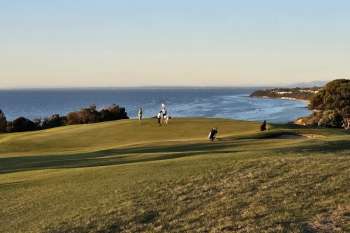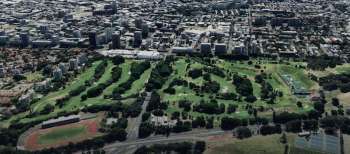Into the eye of the Shark
Back in June I had the honor of interviewing my golfing idol, Greg Norman, one-on-one for a feature article in Australian Golf Digest magazine. It was my first direct meeting with the Great White Shark, despite him contributing the foreword to my 2007 publication Planet Golf.
It was with great excitement that I headed up to the Sunshine Coast in Queensland, to not only talk with Norman, but also review bunkering alterations he had proposed at the Pelican Waters Golf Club. Oddly, during our time on site these design changes were not made available, and it remains unclear precisely what he has in mind for a course that was designed while Bob Harrison was in charge of his Australasian operations.
Although Norman’s schedule was crazy tight, and he spent the first few minutes dressing me down for suggesting Harrison’s departure from the GNGCD company was newsworthy, he was ultimately generous with his time and happy to talk about his business, his design philosophies and how employees of the company are publicly recognized.
For me, the most interesting comment was Norman’s explanation that closing down his Australian design operations was a boon for local clients, because they could now deal directly with Great White Shark HQ rather than a ‘satellite’ Sydney office.
His comments seem to contradict remarks published in his book ‘The way of the Shark’ about the advantages of having the two design offices. In that book, co-authored by Donald T. Phillips, Norman states that ‘Unlike our competition, we adopted a decentralized approach, with two offices 10,000 miles apart. One group handled Asia-Pacific and the other handled the Americas. This arrangement means that ‘supply lines’ between the office and the client are short-and that allows us to be more responsive and more hands-on in servicing our customers. I believe it has served Greg Norman Golf Course Design well.’
Aside from Doonbeg in Ireland, I believe the best GNGCD courses were those designed by Bob Harrison in collaboration with Norman. It seems reasonable, therefore, to muse over whether Harrison’s departure will affect the quality of the output in the Asia/Pacific region. I believe it will, but none of us will know for sure until Norman’s US team has completed either the redesign of the Grange East in Adelaide or, more crucially, the new 27-hole course for the relocating Eastern Golf Club in Melbourne.
Here now are a few highlights from our chat at Pelican Waters - stay tuned for the full interview in January’s edition of the Australian Golf Digest magazine.
Greg Norman interview
When asked whether his design team would now directly supervise work done in Australia, Norman confirmed they would and then highlighted the advantages (?) of running a global empire from one centralized base.
GN –Somebody from my head office will be here, somebody from my head office will be sitting on a dozer working with David and Tim on the (Pelican Waters) project, so there is direct communication all the time. We do that all over the world, we just never did it in Australia and there were reasons why it couldn’t happen before in Australia. Now, because of the implementation of that, people are going WOW, now we’re getting the complete corporation behind it and support.
On the question of design recognition and, by inference, how the work of long-time collaborator Bob Harrison should be viewed, Norman was quick to claim that he gives credit to his guys …when they deserve it. He then added…
GN – I think at the end of the day when you work for a company, it’s Greg Norman Golf Course Design; it’s not a Bob Harrison Design OK simple as that. I’m sure that if you owned the company you’d probably feel the same way. If somebody’s saying ‘well I designed this but actually I’m working for this guy over here and I really didn’t design it because I’m actually working with him to do it.’
…So you give credit where credit is due and quite honestly the implementation of a design aspect, what I see and what I expect on the ground, because my name is on the door, I expect it to be implemented. I don’t expect to come back sometime and say oh that’s not what I wanted so you gotta redo it, because if you redo it somebody’s got to pay for it and I don’t believe in that. I pride myself on implementing things where the costing is kept to a minimum and obviously the execution long term you include in there. Long term is what I see, I see things 25 years down the line, 20 years down the line and I want to make sure those things implemented today are not handed off to somebody else in a very very expensive fashion.
When asked whether his ambition was to build as many courses as Jack Nicklaus or as many gems as Alister MacKenzie?
GN - It’s not the quantity to me, that’s got nothing to do with it. It is the deliverable, which you have on the ground over a period of time is the thing that’s most important to me, and testimony to that is people’s memory of the golf course. I don’t build golf courses as a monument to myself, I build golf courses because I enjoy building golf courses for people, and so this is the big difference between me as an architect and what people think.
When asked what he thought of the European Golf Design / IMG Golf Course Services approach to signature design….
GN - I don’t agree with that model. I was a consultant on two projects, and I didn’t like being a consultant on those projects because at the end of the day all they are doing is using your name, and they’re not using your experience or your expertise. Anybody can do that. I could go ask Darius Oliver to come in and be a consultant to Greg Norman Golf Course Design and give you x dollars and say go deal, OK. That doesn’t wash with me, to me your credentials and your credibility is independently running and owning and operating a company because your name is on the door.
We ended the discussion talking about rankings and accolades, and specifically a new Norman course in Texas that had been well received by the media.
Norman remarked ‘My guys email me that stuff (rankings) all the time, but I really don’t care. If they love the golf course that’s fine, I did my job, great. You know accolades and all that comes with it, I go into every golf course design project hoping that that’s going to happen, but I don’t need it. I don’t want to be up there number 1 in golf course design or this and that. It’s the same philosophy I had in golf. I never wanted to be the number 1 player in the world; I only wanted to be the best player I could be. I just want to be the best golf course designer I can be.
Back to NewsMore News
Report reveals golf's $3.3 billion contribution to Australia
AGIC report reveals total annual benefits to the Australian community, economy and environment from golf.
Cape Wickham Links – The Inside Design Story
Co-designer Darius Oliver reveals the truth behind the design of Australia’s premier modern golf course
Have your say on the future of Moore Park Golf
Golfers unite – another one of our cherished public access golf courses is under threat
Cameron John wins The National Tournament by two strokes
Victorian claims breakthrough professional victory at The National Tournament presented by BMW



